Basilica of Santa Sabina, 422–432, Rome
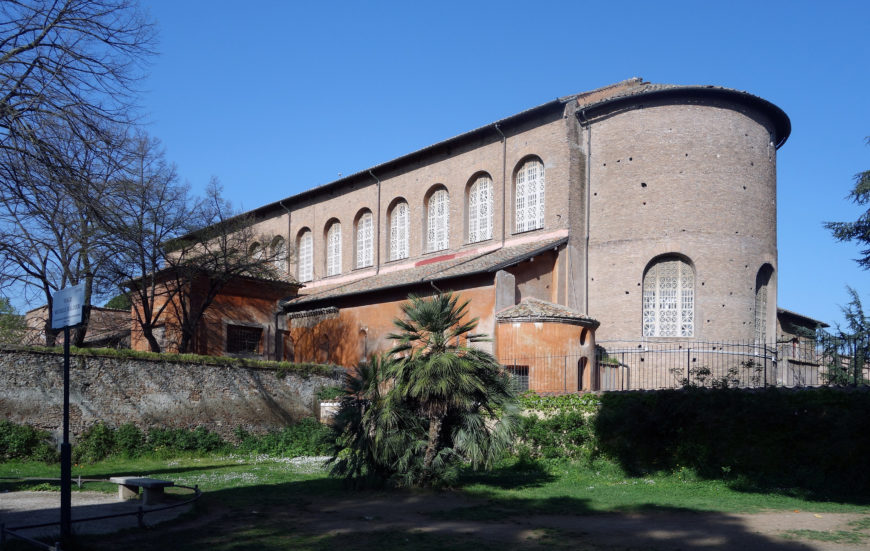
Exterior view of the apse, Basilica of Santa Sabina, c. 432 C.E., Rome (photo: Steven Zucker, CC BY-NC-SA)
Basilicas—a type of building used by the ancient Romans for diverse functions including as a site for law courts—is the category of building that Constantine’s architects adapted to serve as the basis for the new churches. The original Constantinian buildings are now known only in plan, but an examination of a still extant early fifth century Roman basilica, the Church of Santa Sabina, helps us to understand the essential characteristics of the early Christian basilica.
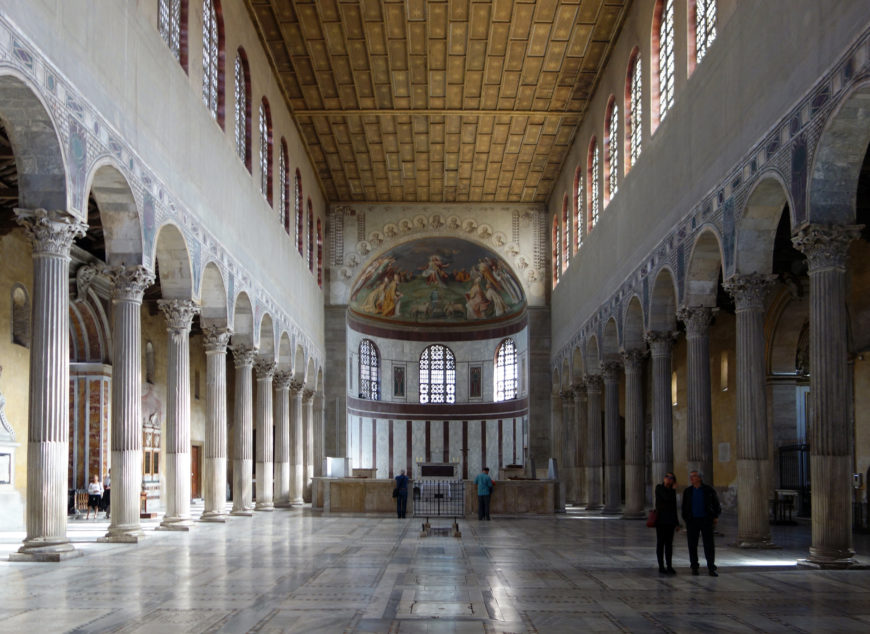
View down the nave towards the apse, Basilica of Santa Sabina, c. 432 C.E., Rome (photo: Steven Zucker, CC BY-NC-SA 2.0)
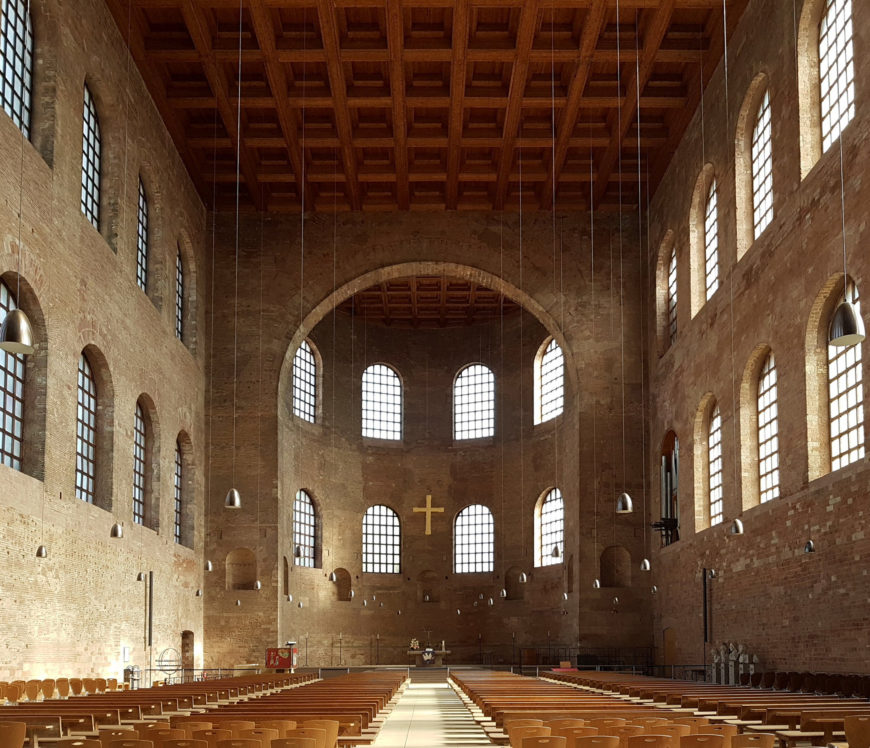
Basilica of Constantine (also known as the Aula Palatina), 4th century C.E., Trier, Germany (photo: Kleon3, CC BY-SA 4.0)
Like the Trier basilica, the Church of Santa Sabina has a dominant central axis that leads from the entrance to the apse, the site of the altar. This central space is known as the nave, and is flanked on either side by side aisles. The architecture is relatively simple with a wooden, truss roof. The wall of the nave is broken by clerestory windows that provide direct lighting in the nave. The wall does not contain the traditional classical orders articulated by columns and entablatures. Now plain, the walls apparently originally were decorated with mosaics.
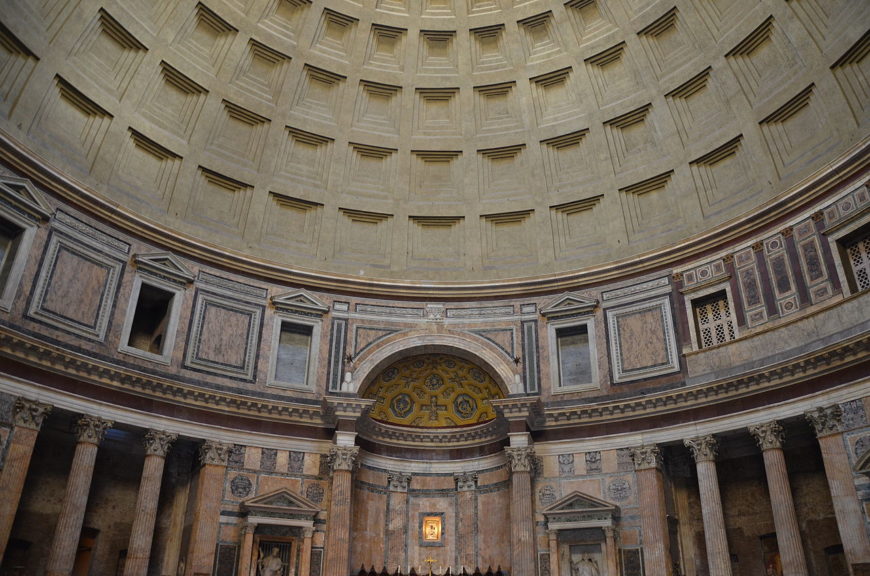
Interior view, The Pantheon, c. 125 C.E., Rome (photo: Carole Raddato, CC BY-SA 2.0)
This interior would have had a dramatically different effect than the classical building. As exemplified by the interior of the Pantheon constructed in the second century by the Emperor Hadrian, the wall in the classical building was broken up into different levels by the horizontals of the entablatures. The columns and pilasters form verticals that tie together the different levels. Although this decor does not physically support the load of the building, the effect is to visualize the weight of the building. The thickness of the classical decor adds solidity to the building.
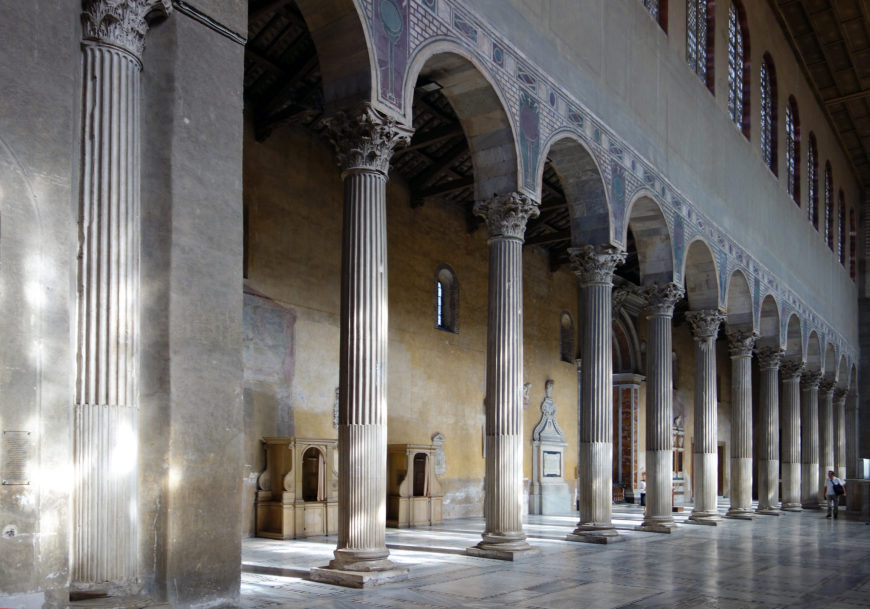
View of the aisle, Basilica of Santa Sabina, c. 432 C.E., Rome (photo: Steven Zucker, CC BY-NC-SA 2.0)
In marked contrast, the nave wall of Santa Sabina has little sense of weight. The architect was particularly aware of the light effects in an interior space like this. The glass tiles of the mosaics would create a shimmering effect and the walls would appear to float. Light would have been understood as a symbol of divinity. Light was a symbol for Christ. The emphasis in this architecture is on the spiritual effect and not the physical. The opulent effect of the interior of the original Constantinian basilicas is brought out in a Spanish pilgrim’s description of the Church of the Holy Sepulcher in Jerusalem:
The decorations are too marvelous for words. All you can see is gold, jewels and silk. . . . You simply cannot imagine the number and sheer weight of the candles, tapers, lamps and everything else they use for the services. . . . They are beyond description, and so is the magnificent building itself. It was built by Constantine and . . . was decorated with gold, mosaic, and precious marble, as much as his empire could provide.
Additional resources
Age of Spirituality: Late Antique and Early Christian Art, Third to Seventh Century (online catalog from The Metropolitan Museum of Art).
Mary Joan Leith and Allyson Sheckler, “The Crucifixion Conundrum and the Santa Sabina Doors,” Harvard Theological Review, 2010.
Smarthistory images for teaching and learning:
[flickr_tags user_id = “82032880@N00” tags = “santa sabina,”]
[0:00] [music]
Dr. Steven Zucker: [0:06] We are at the top of the Aventine Hill in Rome, at the Basilica of Santa Sabina.
Dr. Beth Harris: [0:11] This dates to the 400s, only a hundred years or so after Constantine legalizes Christianity.
Dr. Zucker: [0:18] It’s got a fabulous view of the city of Rome, and it feels like an important place.
Dr. Harris: [0:24] The great ancient Roman temples were on nearby hills, like on the Capitoline Hill was the ancient pagan temple dedicated to Jupiter. It made sense to be here to speak of the new official religion of the Roman Empire.
Dr. Zucker: [0:38] Now, the early Christians did not invent an entirely new architecture. Instead, they looked back to large-scale building from ancient Rome. They repurposed the basilica. This was, in ancient pagan Rome, an administrative structure. It’s interesting to compare the religious structures of the pagan and the Christian.
[0:57] When we think of a Greek or Roman temple, we’re thinking of a house for the god or goddess being honored, and it would not have much interior space, often just enough for the cult sculpture.
Dr. Harris: [1:08] A basilica is a great structure for the early Christians because it could hold huge numbers of people. It had a sense of imperial authority. It was [a] government building, and so it was associated with the empire, and as an official religion you would want to communicate that.
[1:23] The other important thing was that a basilica could have a longitudinal axis. That is, it could focus attention on the opposite end to the entrance, and so large numbers of people could gather for the liturgy with a focus on the altar.
Dr. Zucker: [1:38] We see that here at Santa Sabina. Each of those enormous arches creates a visual rhythm that leads our eye down to this critical point.
Dr. Harris: [1:47] Art historians like to talk about how at Santa Sabina we get a sense of what old St. Peter’s looked like. Now, old St. Peter’s was important because it was built by Constantine. When he legalized Christianity, he set about building the first churches in important cities all over the empire.
[2:05] Here in Rome he commissioned the building of old St. Peter’s, which got rebuilt in the Renaissance.
Dr. Zucker: [2:11] The original St. Peter’s was about a hundred years older than Santa Sabina, so this building gives us a sense of what that building looked like. However, that building did have a couple of important differences. It was much larger than Santa Sabina.
[2:24] It was on an imperial scale, but also, importantly the ceiling of the nave was truss, and it had a double aisle on either side of the nave to help accommodate movement of so many people through that space.
Dr. Harris: [2:37] The old St. Peter’s, and the new St. Peter’s rebuilt in the Renaissance, was the burial place of St. Peter. It was a very important pilgrimage site. It had to accommodate large numbers of people.
[2:47] It’s so wonderful that we get some sense of what that church, commissioned by Constantine, looked like when we go into Santa Sabina.
Dr. Zucker: [2:54] There’s one particularly interesting element in the porch. Let’s take a look at it before we go inside.
Dr. Harris: [2:58] We’re looking at a carved wooden doorway that dates from the 5th century. Now, it’s been heavily restored, but it’s remarkable that a wooden doorway carved with scenes from the Old and New Testament survives from the 5th century.
Dr. Zucker: [3:12] Generally, organic materials like wood don’t last this long, but there’s one particular scene that is interesting to art historians, and it’s all the way in the upper left corner of the door. It may be one of the very first examples of a Crucifixion.
Dr. Harris: [3:27] It’s especially interesting because in most early Christian art we don’t see the Resurrection or the Crucifixion. Mostly we have a focus on Christ’s ministry and miracles.
Dr. Zucker: [3:36] We don’t actually see the cross. What we see is a large central figure with his arms out. Then, on either side are two smaller figures, presumably the two thieves that were crucified on either side of Christ. So, let’s go inside.
Dr. Harris: [3:50] We’ve entered Santa Sabina. The space is quite open. We get a very clear view through the nave and one aisle on either side down toward the apse where the altar is. The apse is that semicircular space opposite the entrance of the church.
[4:06] Unlike so many other later churches, it doesn’t have a transept, that is, an aisle that went across at one end of the church. Here we have a very simple space with the nave, the apse on one end, and one aisle on either side.
Dr. Zucker: [4:20] The space is beautifully and softly lit by sunlight coming in from a clerestory. It’s interesting to note that there’s not glass in there, but a crystalline form of gypsum instead that lets in a tremendous amount of light.
[4:32] Now, this particular church has a flat ceiling above the nave with enormous wooden beams that help to support it. It has a pitched roof above that.
[4:41] One of the most distinctive features of this church is the glorious columns that line either side of the nave. This is spolia. These are columns that were reused from a pagan building and here have been repurposed in this Christian context.
Dr. Harris: [4:55] These columns carry a nave arcade of arches.
Dr. Zucker: [4:59] In the spandrels of the arches facing the nave are images created out of inlaid stone that show a chalice and bread plates. Repeatedly, down the length of the nave, we have a reference to the Eucharist.
Dr. Harris: [5:12] We see that also in the apse. The Eucharist, or Holy Communion, is part of the Christian liturgy, where the priest enacts the sacrifice and resurrection of Christ by offering the bread and the wine which are miraculously the body and blood of Christ.
Dr. Zucker: [5:27] This building type will go on to be a source for the architecture of Christian churches throughout the rest of history.
Dr. Harris: [5:34] Although mostly with a transept, which comes to signify the cross that Christ was crucified on. Between the nave arcade and the clerestory, we have a wall that in most early Christian churches would’ve contained decoration — fresco or mosaic like in the church of Sant’Apollinare Nuovo in Ravenna. Here those decorations are gone.
Dr. Zucker: [5:53] One of the other most appealing features of this church is the screen, which separates the sanctuary from the nave. It is elaborately carved.
[6:01] Santa Sabina gives us a sense of what the earliest Christian buildings looked like as it looks back to the pagan tradition. At the same time, it also sets up the form that so many Christian churches after will follow.
Dr. Harris: [6:13] Like so many churches in Rome over the centuries, the space has been transformed. There are two Baroque chapels that have been added, but so much remains of Santa Sabina’s original form that we really do get to be transported back in time to the 5th century.
[6:30] [music]




